Introduction
Organizations – especially those in the new technology areas – have always focused on the magic mantra of 'Growth'. Part of this growth has been achieved through organic growth – increase in the number of products and service offerings, number of markets served, channels through which customers are served etc. Another route for growth has been mergers and acquisitions. In addition, rapid technological advancement, feisty competitors and demanding customers have forced organizations to be much more aggressive in the way they address their markets. The result – Increased complexity across the value chain!
Traditionally, company executives have focused on complexity issues that are 'customer-facing'. There are constant reviews of product and service configurations, brands and product lines, distribution channels and number of SKUs – with an objective of rationalizing these heads and optimizing the overall customer service model. However, these also drive complexity in 'non-customer facing' areas such as distribution, manufacturing and procurement. These have typically been given lower priorities in the past.
A recent survey of CPOs across industry groups has indicated that this is changing! As Figure 1 illustrates, 'complexity management in procurement' has become one of the top 5 annual objectives for CPOs as part of their savings delivery programs.
In fact, after procurement professionals exhaust traditional savings approaches viz., rate negotiations, volume consolidation, and even low cost country sourcing – complexity management becomes the one of the most important tools to drive significant savings. This paper shares GEP's perspective on how to manage complexity and drive savings through that in procurement. We illustrate this through a case study of the work done for a bio-technology major recently.
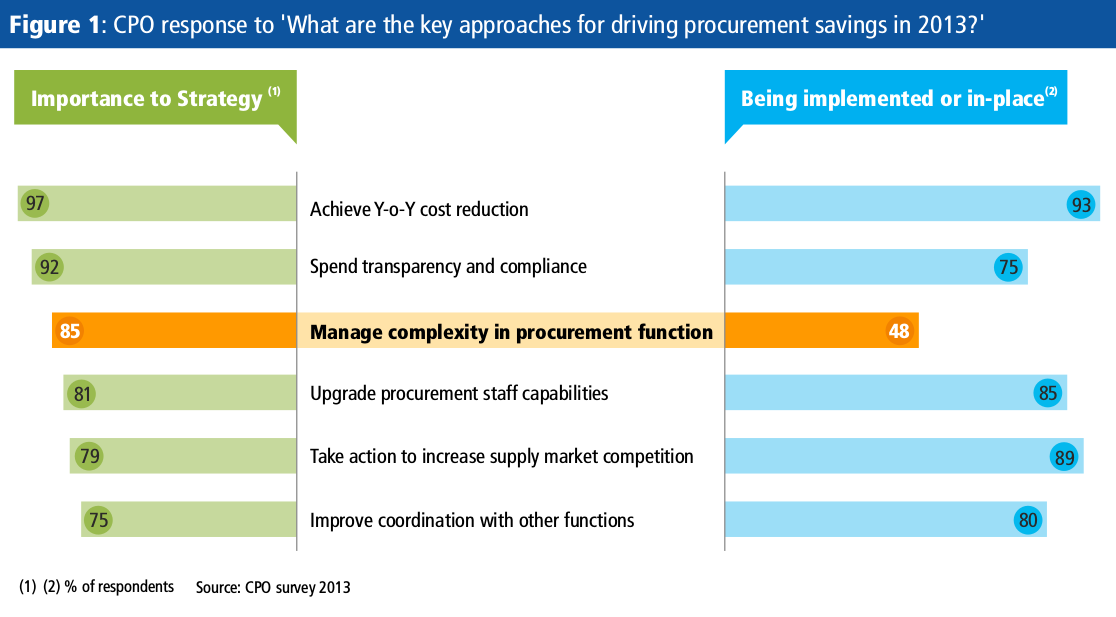
Sources of Procurement Complexity
Procurement complexity is driven by multiple factors, as illustrated in Figure 2.
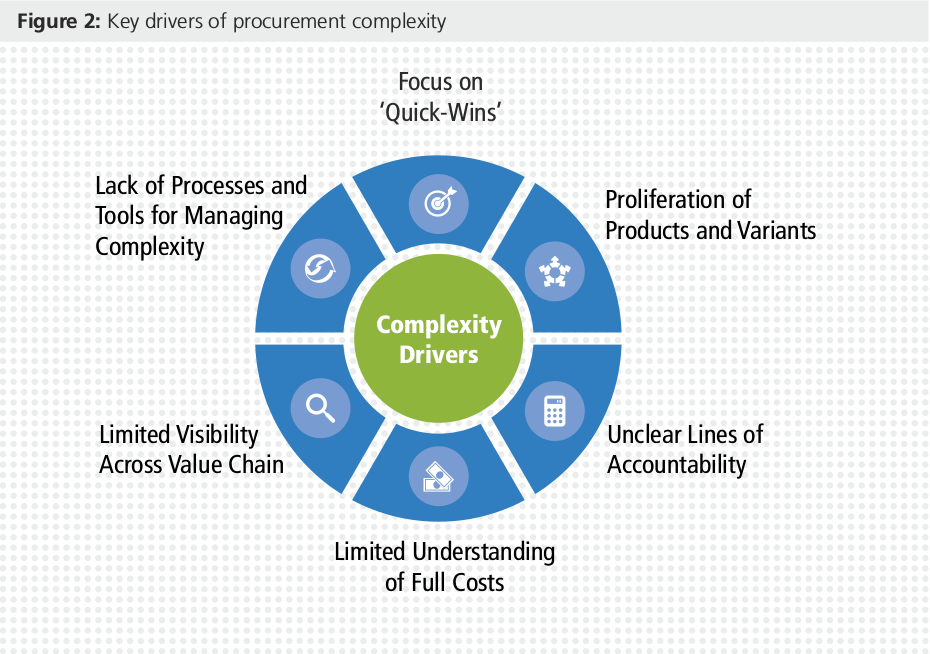
Focus on 'Quick-Wins': As mentioned earlier, focus of procurement executives have traditionally been to 'meet savings targets for this year'! This translates into intense negotiations with suppliers, moving businesses to suppliers in low cost country locations as well as volume consolidation with a fewer suppliers. While these approaches are required, it misses the 'forest for the trees'. Continued short-term savings focus can result in a proliferation of suppliers, material specifications, inbound logistic channels as well as related procure-to-pay processes. In the long term, this can add significant complexity in terms of the number of supplier-material combinations to be managed by procurement.
Proliferation of products and variants: Rapid growth in sales product and service portfolio translates directly into exponential increase in the complexity of procured goods and services. As seen in Figure 3, a marginal increase in the number of SKUs in the sales side translates into a significant increase down the value chain in procurement. This is illustrated in the snap-shot of a typical complexity funnel for an instruments manufacturing company.
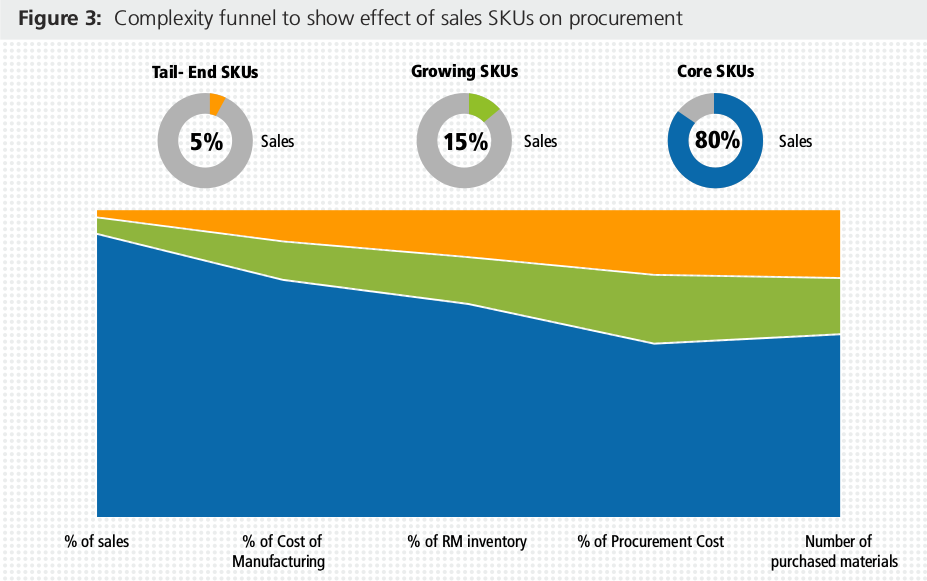
Unclear lines of accountability: In most organizations, decisions are made without reviewing related processes and impact of the increased complexity on the same. Sales and Marketing make decisions regarding brands and product lines with a look at the revenue impact. While this approach is correct, it is also incomplete. Planning for complexity helps procurement and manufacturing determine the changes they need to incorporate in their functions to manage the same. For example, introduction of a new SKU may translate into sourcing multiple raw materials from multiple suppliers across new geographies.
Limited understanding of full costs: There is very little analysis done on the impact of increase in complexity across the value chain. This is a result of incomplete understanding of the true costs across the value chain. For example, introduction of a new packaging for a product may have implications for higher packaging costs, more inventory to be maintained, new suppliers to be identified and whole lot of qualification process – especially where the products are used in critical applications such as life sciences or pharma products.
Limited visibility across value chain: Decisions made by sales and marketing team about introduction of new brands may not factor in all the changes in processes required or implications for the procurement function – primarily due to the organizational silos observed in most companies.
Lack of processes and tools for managing complexity: Most organizations do not employ a structured set of tools and approaches to manage the complexity across the value chain. As a result, increased complexity goes noticed but unmanaged for a long time – translating into higher costs down the value chain.
Procurement Complexity Management Framework
Our focus for complexity management will be restricted in this paper to the procurement function. Based on our experience with working at multiple client organizations across industry verticals, GEP has developed a structured approach towards managing complexity in the procurement function.
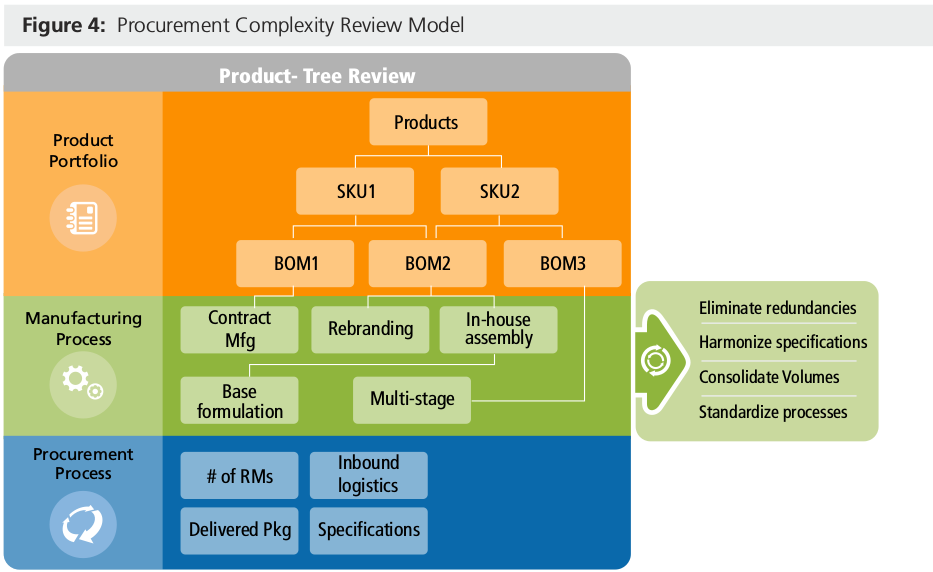
We use the 'Product-Tree review' shown in Figure 4 to determine the impact of each SKU family on the procurement portfolio. This tree is used to identify all the variants across each SKU across processes and purchased materials. This will help in identifying the key variants at each level and the drivers of the complexity. Once the drivers are identified, the next step is to brainstorm on potential ways to reduce complexity. This is achieved through a 4-pronged approach:
Elimination of redundancies: Are there any activities that are being duplicated across SKU families? If so, is there an opportunity to delete the duplication of efforts and consolidate into the same process?
Harmonization of specifications: Can the raw material specifications be standardized across similar product groups? This can result in volume increase, elimination of multiple inventory requirements as well as cost reduction at the supplier side.
Volume consolidation: Can volumes across similar raw materials be consolidated and sourced from a rationalized set of suppliers?
Standardization of processes: Can quality inspection parameters be standardized for similar raw material groups?
The above questions are typically addressed through joint workshops held with participants from sales, manufacturing and procurement functions. Key pre-requisites for the workshops to be successful include:
- Access to detailed data
- Open mindedness towards the areas being scrutinized
- Participation of all functions, not just procurement
- Support from leadership
Business Impact
Complexity management has several benefits, including the following:
- Reduction in material costs
- Reduction in inbound and outbound packaging costs
- More effective product portfolio management for raw materials
- Efficiency in supplier relationship management
- More bandwidth for materials managers to focus proactively on supply markets
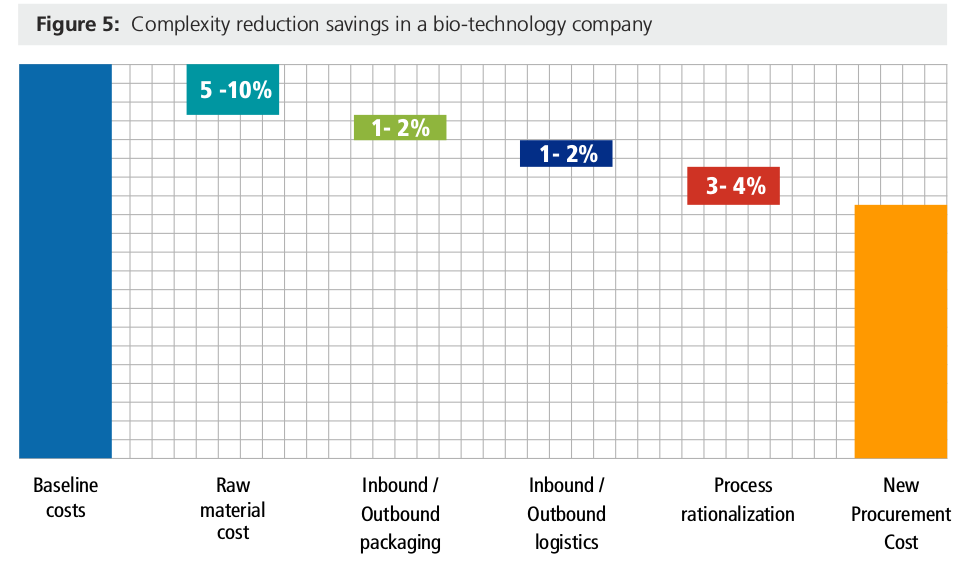
Figure 5 summarizes the results obtained through the complexity management review for a bio technology company. A thorough review of the product portfolio for the company and the consequent complexity reduction in the nput materials spanning chemicals, biological materials and electronic instrumentation resulted in an overall reduction of cost of procurement in the range of 10 – 20%.
Unlock savings through complexity reduction
Complexity management is by no means a 'quick-win' project or a procurement-driven program. It is hard-work, requires patience and needs a lot of support from the entire organization. Consistent and holistic complexity management is one of the most important levers that the organization has to drive down their overall costs significantly.

